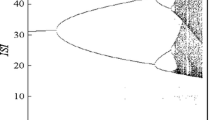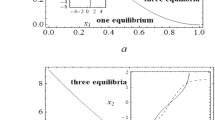Abstract
This paper is concerned with bifurcations and chaos control of the Hindmarsh-Rose (HR) neuronal model with the time-delayed feedback control. By stability and bifurcation analysis, we find that the excitable neuron can emit spikes via the subcritical Hopf bifurcation, and exhibits periodic or chaotic spiking/bursting behaviors with the increase of external current. For the purpose of control of chaos, we adopt the time-delayed feedback control, and convert chaos control to the Hopf bifurcation of the delayed feedback system. Then the analytical conditions under which the Hopf bifurcation occurs are given with an explicit formula. Based on this, we show the Hopf bifurcation curves in the two-parameter plane. Finally, some numerical simulations are carried out to support the theoretical results. It is shown that by appropriate choice of feedback gain and time delay, the chaotic orbit can be controlled to be stable. The adopted method in this paper is general and can be applied to other neuronal models. It may help us better understand the bifurcation mechanisms of neural behaviors.
Similar content being viewed by others
References
Izhikevich E M. Neural excitability, spiking and bursting. Inter J Bifurcation Chaos, 2000, 10: 1171–1266
Duan L X, Zhai D H, Lu Q S. Bifurcation and bursting in Morris-Lecar model for class I and class II excitability. Discrete and Continuous dynamical systems (supplement), 2011: 391–399
Wang H X, Wang Q Y, Lu Q S. Bursting oscillations, bifurcation and synchronization in neuronal systems. Chaos, Solitons & Fractals, 2011, 44: 667–675
Wang Q Y, Duan Z S, Feng Z S, et al. Synchronization transition in gap-junction-coupled leech neurons. Phys A, 2008, 387: 4404–4410
Duan L X, Lu Q S, Cheng D Z. Bursting of Morris-Lecar neuronal model with current-feedback control. Sci China Tech Sci, 2009, 52: 771–781
Duan L X, Fan D G, Lu Q S. Hopf bifurcation and bursting synchronization in an excitable systems with chemical delayed coupling. Cogn Neurodyn, 2013, 7: 341–349
Wang H X, Wang Q Y, Lu Q S, et al. Equilibrium analysis and phase synchronization of two coupled HR neurons with gap junction. Cogn Neurodyn, 2013, 7: 121–131
Hu G, Xiao J H, Zheng Z G. Chaos Control (in Chinese). Shanghai: Shanghai Technol Education Publishing House, 2000
Rabinovich M I, Abarbanel H D I. The role of chaos in neural systems. Neuroscience, 1998, 87: 5–14
Yu H J, Peng J H. Chaotic synchronization and control in nonlinear-coupled Hindmarsh-Rose neural systems. Chaos, Solitons & Fractals, 2006, 29: 342–348
Korn H, Faure P. Is there chaos in the brain? II. Experimental evidence and related models. C. R. Biologies, 2003, 326: 787–840
Pikovsky A, Rosenblum M, Kurths J. Synchronization: A Universal Concept in Nonlinear Sciences. Cambridge: Cambridge UnivPress, 2001
Hubler A. Adaptive control of chaotic systems. Helv. Phys. Acta, 1989, 62: 343–346
Ott E, Grebogi C, Yorke J A. Controlling chaos. Phys Rev Lett, 1990, 64: 1196–1199
Pyragas K. Continuous control of chaos by self-controlling feedback. Phys Lett A, 1992, 170: 421–428
Yang T, Yang C. Control of Rössler system to periodic motions using impulsive control methods. Phys Lett A, 1997, 232: 356–361
Rafikov M, Balthazar J M. On an optimal control design for Rössler systems. Phys Lett A, 2004, 333: 241–245
Chen C, Yan J, Liao T. Sliding mode control for synchronization of Rössler systems with time delays and its application to secure communication. Phys Scr, 2007, 76: 436–441
Agiza H N, Yassen M T. Synchronization of Rössler and Chen chaotic dynamical systems using active control. Phys Lett A, 2001, 278: 191–197
Chen Y Y, Peng J H, Shen Q H, et al. Defining the controlling conditions of low-dimensional chaotic systems controlled by time-delayed feedback (in Chinese). Acta Physica Sinica, 2001, 50:1871–1875
Liu B Z, Peng J H. Nonlinear Dynamics. Beijing: Higher Education Press, 2004
Song Y L, Wei J J. Bifurcation analysis for Chen’s system with delayed feedback and its application to control of chaos. Chaos, Solitons & Fractals, 2010, 4: 75–91
Ding Y T, Jiang W H, Wang H B. Delayed feedback control and bifurcation analysis of Rössler chaotic system. Nonlinear Dyn, 2010, 61: 707–715
Xu M H, Wei Y, Wei J J. Bifurcation analysis of Rössler system with multiple delayed feedback. Electronic Journal of Qualitative Theory of Differential Equations. 2010, 63: 1–22
Yu H J, Tong W J. Chaotic control of hindmarsh-rose neuron by delayed self-feedback. Acta Phys Sin, 2009, 58: 2977–2982
Schöll B E, Hiller G, Hövel P, et al. Time-delayed feedback in neurosystems. Phil Trans R Soc A, 2009, 367: 1079–1096
Hale J K. Theory of Functional Differential Equation. New York: Springer-Verlag, 1997
Kuznetsov Y A. Elements of Applied Bifurcation Theory. New York: Springer-Verlag, 1995
Author information
Authors and Affiliations
Corresponding author
Rights and permissions
About this article
Cite this article
Wang, H., Wang, Q. & Zheng, Y. Bifurcation analysis for Hindmarsh-Rose neuronal model with time-delayed feedback control and application to chaos control. Sci. China Technol. Sci. 57, 872–878 (2014). https://doi.org/10.1007/s11431-014-5535-z
Received:
Accepted:
Published:
Issue Date:
DOI: https://doi.org/10.1007/s11431-014-5535-z




